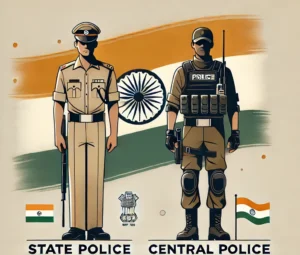Indian Police Ranks and Structure – Explained
The Indian police force is tasked with maintaining law and order, preventing crimes, and safeguarding citizens. The system is divided into two main categories: State Police and Central Police, each having its own ranking structure. The ranks are categorized into Officers and Non-Commissioned Officers (NCOs), which include constables and head constables. These ranks ensure that police work is carried out effectively with clear roles and responsibilities.

Indian Police Structure
The police in India operates at two levels:
- State Police: Each state has its own police force, led by the Director General of Police (DGP).
- Central Police: These forces are under the Ministry of Home Affairs and deal with national issues like counter-terrorism and border security. Examples include the Central Bureau of Investigation (CBI) and Border Security Force (BSF).
Though there are slight variations, the ranks across both state and central forces are largely similar.
Police Ranks in the Indian State Police
Officers in the State Police
- Director General of Police (DGP)
The highest-ranking officer in a state’s police force, overseeing all police functions in the state. - Additional Director General of Police (ADGP)
Assists the DGP in managing departments and operations within the state. - Inspector General of Police (IGP)
Responsible for managing regions or zones, and supervising police operations within their jurisdiction. - Deputy Inspector General of Police (DIGP)
Oversees a district or large jurisdiction, managing police operations and law enforcement coordination. - Senior Superintendent of Police (SSP)
In charge of the police force in a district, ensuring law and order are maintained and addressing crimes. - Superintendent of Police (SP)
Manages police operations at the district level, coordinating with police stations and overseeing crime control. - Deputy Superintendent of Police (Dy.SP)
Oversees a sub-division within a district, often the first rank promoted from lower positions. - Inspector
Heads a police station and leads investigations, arrests, and enforces law within the area. - Sub-Inspector (SI)
Oversees operations at the police station level, assisting with investigations and managing day-to-day law enforcement duties. - Assistant Sub-Inspector (ASI)
Assists in managing station activities, maintaining records, coordinating patrols, and supervising constables. - Head Constable
Supervises a team of constables, aiding higher officers in operations, investigations, and patrols. - Constable
The lowest rank, responsible for patrolling, emergency response, managing traffic, and maintaining public order.
Police Ranks in the Indian Central Police Forces
Central police forces such as the Central Reserve Police Force (CRPF), Border Security Force (BSF), and CBI follow a similar rank structure but with some distinctions.
Central Police Ranks
- Director General (DG)
The highest-ranking officer in a central police organization, overseeing the operations of the entire force at the national level. - Additional Director General (ADG)
Assists the DG and manages various units or regions within the force. - Inspector General (IG)
Manages the administrative duties of regions or special units, ensuring efficient police operations. - Deputy Inspector General (DIG)
Oversees large regions or special units, coordinating security operations and law enforcement. - Commandant
In charge of a battalion or unit, ensuring operational readiness and overseeing its management. - Second-in-Command (2IC)
Assists the Commandant in the management of the unit’s day-to-day operations. - Deputy Commandant
Works directly under the Commandant, assisting with force leadership and management. - Assistant Commandant
Junior officers responsible for smaller units and supporting senior officers in operations. - Sub-Inspector (SI)
Similar to state police, oversees small teams of constables or junior officers during operations. - Assistant Sub-Inspector (ASI)
Assists with managing operational activities and field operations, similar to their role in state police. - Head Constable
Supervises constables and helps ensure smooth operations in fieldwork. - Constable
Executes various tasks including patrolling, security operations, and providing public assistance during emergencies.
Summary
The Indian police force is organized into State and Central categories, each with its structured ranking system. The ranking structure defines the responsibilities at various levels, with the DGP leading the state police and the DG heading central police forces. Officers, inspectors, sub-inspectors, and constables each play specific roles in law enforcement, ensuring the safety and security of the public.
Understanding the rank structure reveals how personnel are organized to effectively manage law and order, conduct investigations, and maintain security operations.
Tags: Additional Director General, Assistant Commandant, assistant sub-inspector, BSF ranks, CBI ranks, central police, Commandant, constable, crime prevention, CRPF ranks, Deputy Commandant, Deputy Inspector General, Deputy Superintendent of Police, Director General of Police, field operations, head constable, Indian law enforcement, Indian Police, Indian police force, Indian police hierarchy, inspector, Inspector General of Police, law and order, Ministry of Home Affairs, non-commissioned officers, police administration, police duties, police investigations, police leadership., police officers, police patrol, police ranks, police responsibilities, police stations, police structure, public safety, Second-in-Command, Senior Superintendent of Police, state police, sub-inspector, Superintendent of Police


